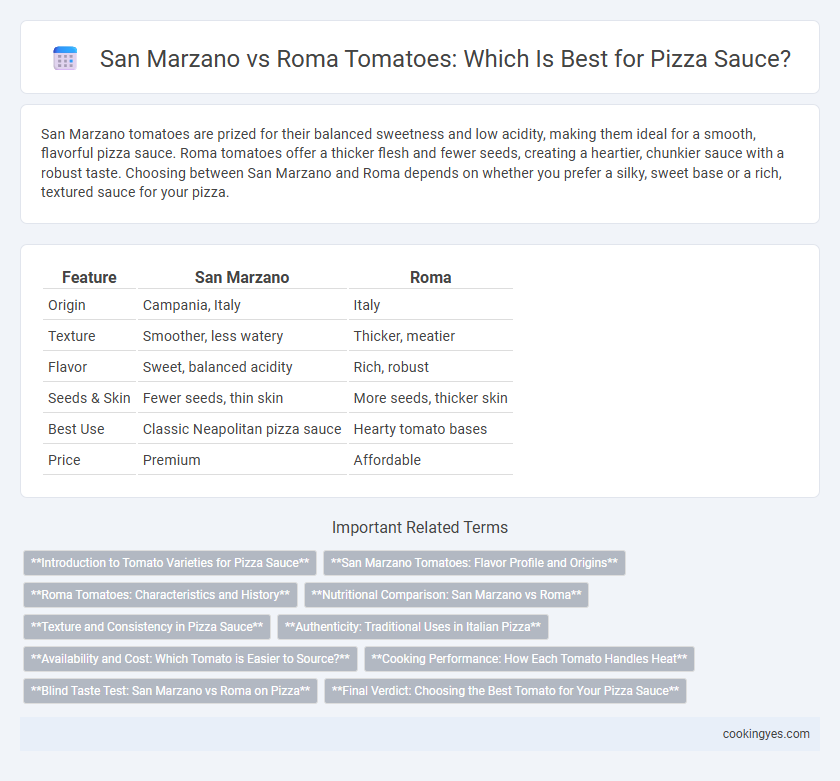San Marzano tomatoes are prized for their balanced sweetness and low acidity, making them ideal for a smooth, flavorful pizza sauce. Roma tomatoes offer a thicker flesh and fewer seeds, creating a heartier, chunkier sauce with a robust taste. Choosing between San Marzano and Roma depends on whether you prefer a silky, sweet base or a rich, textured sauce for your pizza.
Table of Comparison
| Feature | San Marzano | Roma |
|---|---|---|
| Origin | Campania, Italy | Italy |
| Texture | Smoother, less watery | Thicker, meatier |
| Flavor | Sweet, balanced acidity | Rich, robust |
| Seeds & Skin | Fewer seeds, thin skin | More seeds, thicker skin |
| Best Use | Classic Neapolitan pizza sauce | Hearty tomato bases |
| Price | Premium | Affordable |
Introduction to Tomato Varieties for Pizza Sauce
San Marzano tomatoes are prized for their sweet flavor, low acidity, and dense flesh, making them ideal for a smooth, rich pizza sauce. Roma tomatoes offer a firmer texture with a slightly tangier taste, providing a robust base that holds up well during cooking. Both varieties contribute unique qualities to pizza sauce, influencing flavor, consistency, and overall sauce balance.
San Marzano Tomatoes: Flavor Profile and Origins
San Marzano tomatoes, grown in the volcanic soil of the Agro Sarnese-Nocerino region near Naples, Italy, are prized for their balanced sweetness, low acidity, and vibrant, rich flavor ideal for authentic Italian pizza sauces. Their firm flesh, few seeds, and thin skin create a smooth texture that blends seamlessly into sauces, enhancing rather than overpowering the dough's flavor. Originating from a specific protected designation of origin (PDO) zone, San Marzano tomatoes consistently deliver a distinctive taste that sets traditional Neapolitan pizza apart from those using Roma tomatoes.
Roma Tomatoes: Characteristics and History
Roma tomatoes, prized for their dense flesh and low moisture content, are ideal for a thick, rich pizza sauce base that prevents sogginess. Originating from Italy, Roma tomatoes have a long history of cultivation, known for their robust flavor and fewer seeds compared to other varieties. Their firm texture and slightly sweet taste enhance the overall quality of tomato sauces used in traditional and contemporary pizza recipes.
Nutritional Comparison: San Marzano vs Roma
San Marzano tomatoes contain higher levels of natural sugars and vitamins A and C compared to Roma tomatoes, enhancing both flavor and nutritional value in pizza sauce. Roma tomatoes offer a denser flesh with more lycopene, an antioxidant linked to heart health and cancer prevention. Choosing San Marzano results in a sweeter, nutrient-rich sauce, while Roma delivers a thicker texture with potent antioxidant benefits.
Texture and Consistency in Pizza Sauce
San Marzano tomatoes provide a smoother, less watery texture ideal for a thick, rich pizza sauce consistency that adheres well to the dough. Roma tomatoes have a denser flesh and lower moisture content, creating a chunkier and slightly grainier sauce texture. The choice between San Marzano and Roma affects the balance of sauce thickness and texture, with San Marzano favored for a silkier blend and Roma for a more robust, hearty consistency.
Authenticity: Traditional Uses in Italian Pizza
San Marzano tomatoes hold a prestigious reputation in Italian pizza making due to their authentic use in traditional Neapolitan sauces, prized for their balanced sweetness and low acidity. Roma tomatoes, while also popular for sauce bases, are often used in more rustic or everyday Italian recipes but lack the specific regional heritage of San Marzano. The authenticity of San Marzano tomatoes in pizza sauce is reinforced by their Protected Designation of Origin (PDO) status, which ties them directly to the historic pizza-making regions of Italy.
Availability and Cost: Which Tomato is Easier to Source?
San Marzano tomatoes, grown primarily in the volcanic soil of Italy's Campania region, are often more expensive and harder to source outside Europe due to limited production and protected designation of origin (PDO) status. Roma tomatoes are widely cultivated globally, making them more readily available and cost-effective for pizza sauce bases in most markets. The affordability and accessibility of Roma tomatoes make them a practical choice for pizzerias needing consistent supply and budget-friendly ingredients.
Cooking Performance: How Each Tomato Handles Heat
San Marzano tomatoes maintain a robust structure and rich sweetness when exposed to high heat, resulting in a smooth, balanced tomato sauce that enhances the pizza's flavor without becoming watery. Roma tomatoes, while offering a thicker flesh and lower moisture content, can break down more quickly under intense cooking, sometimes leading to a slightly grainier texture in the sauce. Chefs often prefer San Marzano for its superior heat resistance and consistent cooking performance in traditional Neapolitan-style pizza sauces.
Blind Taste Test: San Marzano vs Roma on Pizza
San Marzano tomatoes are often favored in blind taste tests for their balanced sweetness and low acidity, enhancing the depth of flavor in pizza sauce. Roma tomatoes, while slightly more acidic and less sweet, provide a robust and tangy base that some tasters prefer for a traditional pizza experience. The choice between San Marzano and Roma in blind tests typically hinges on individual palate preference, with San Marzano excelling in smoothness and Roma standing out for its vibrant intensity.
Final Verdict: Choosing the Best Tomato for Your Pizza Sauce
San Marzano tomatoes offer a sweeter, less acidic flavor that creates a rich and balanced pizza sauce, making them the preferred choice for authentic Neapolitan-style pies. Roma tomatoes provide a thicker, meatier texture with a slightly tangier taste, ideal for those seeking a heartier, more robust sauce. Ultimately, selecting San Marzano for smooth, sweet sauce or Roma for intensified texture and flavor depends on the desired pizza style and sauce consistency.
San Marzano vs Roma for tomato sauce base Infographic

 cookingyes.com
cookingyes.com